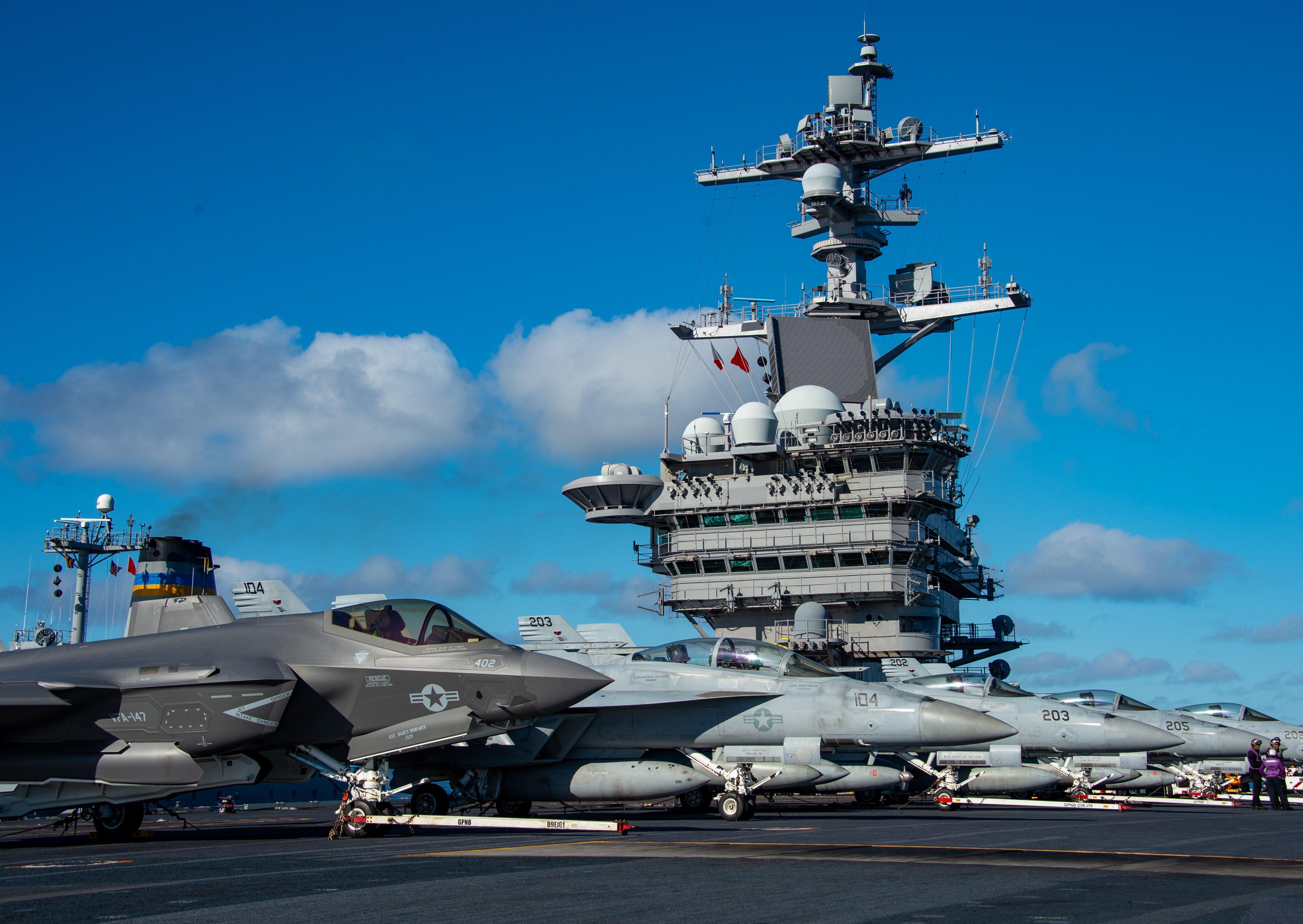
An F-35C Lighting II from the ‘Argonauts’ Strike Fighter Squadron (VFA) 147, left, a F/A-18F Super Hornet from the ‘Bounty Hunters’ VFA 2, center, and F/A-18E Super Hornets from the ‘Stingers’ VFA 113, right, sit on the flight deck of the USS Carl Vinson (CVN-70) on Jan 30, 2021. US Navy Photo
Navy officials told a key House panel this week that by creating a different mix of aircraft in the future carrier air wing, the service could shave five years off the timetable to close the shortfall in its strike fighter aircraft inventory.
By 2025, the Navy will have solved its strike fighter shortfall in part by changing how it will field the F-35C Lighting II Joint Strike Fighter. Instead of two squadrons per air wing with 10 tails, the Navy will now field a single squadron with 14 tails, Rear Adm. Andrew Loiselle, director of the Air Warfare Division (OPNAV/N98), told the House Armed Services subcommittee on tactical air and land forces on Tuesday. testified it was reducing F-35C Lightning II Joint Strike Fight from two to one squadron per air wing.
The Navy sees the upcoming Vinson Carrier strike Group deployment as a demonstration of how the F-35s can operate with older aircraft. Similarly, a Marine Corps F-35B squadron has embarked aboard HMS Queen Elizabeth (R08) for the carrier’s first deployment. The “Wake Island Avengers” of U.S. Marine Fighter Attack Squadron (VMFA) 211 were part of the recent strike missions against ISIS targets in the Middle East.
In addition, to further cut the shortfall, Loiselle told lawmakers the Navy has taken some F-16s from the Air Force and Air [National} Guard for use in training at Naval Air Station Fallon, Nev., to free up more Super Hornets. Additionally, Loiselle said the service also has “returned 28 Super Hornets back into the fleet” that had previously been inactive.
Rep. Vicky Hartzler, (R-Mo.) the ranking member of the panel, pressed Loiselle on the condition of the F/A-18E/F Super Hornets coming into the Service Life Modification program. “Boeing is seeing improvement” in the aircraft the Navy is turning over, said Loiselle.
In part, this is caused by “employing our own artisans’’ to inspect the aircraft before sending them to the contractor. “We are continuing to learn” from the first 30 turned over to Boeing. This step is “bringing down the time” to complete the work to extend flying hours from 6,000 to 10,000.
But it was the cost of operating and maintaining the F-35s used by the Air Force, Navy and Marine Corps, the impact of that spending on current service strike fighters and what it means for the Next Generation Air Dominance (NGAD) program that most concerned committee members.
Panel chairman Rep. Donald Norcross, (D-N.J.) said he found it “unacceptable” that the Navy and Air Force were divesting current aircraft like the A-10 and F/A-18E/F that are still valuable for service to invest in next-generation aircraft when F-35 costs weren’t under control.
Rep. Rob Wittman (R-Va), agreed, noting “all of the dreams of modernization [to next-generation systems … come out of the FDYP [future years defense spending projections].” This means money is put into science and technology and research and development accounts instead of being line-item budget programs.
Jon Ludwigson, the Government Accountability Office’s director of contracting and national security acquisitions, said the F-35 program “has moved ahead despite challenges” like on-time delivery of engines to supply chain disruptions caused by Turkey’s expulsion from the program. In some cases, he said this moving ahead created new problems with existing software and systems.
Problems still exist in Block 4, he and Raymond O’Toole, the Pentagon’s acting director of operational test and evaluation, said.
Despite an April hearing before the same panel on F-35 costs, Ludwigson said the “myriad challenges” in the program call for continued congressional oversight. He added many of the issues GAO raised in its 2020 study of the program remain.
“There have been lots of challenges in the last three or four years” with the F-35 having to adapt to meet expected advances by competitors, Joseph Nogueira, acting director of the Pentagon’s Cost Assessment and Program Evaluation (CAPE) office, said. He added that is on top of the continued high cost of operating and sustaining the Joint Strike Fighter.
He said the solutions do not lay in platforms replacing the Block 4 F-35 or the sixth-generation fighter “but the technologies … particularly the weapons” for these aircraft to be effective in the 2030s.
Looking at the F-35’s impact on the Air Force, Lt. Gen. David Nahom, deputy chief of staff for plans and programs, said, “we’re paying for outstanding but not getting outstanding.” Today and in the immediate future, “we’re filling in the holes with F-16s and A-10s.”
